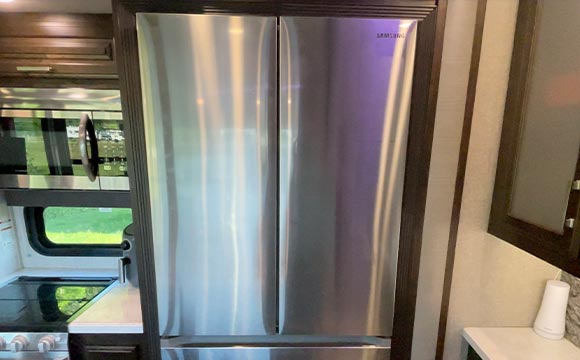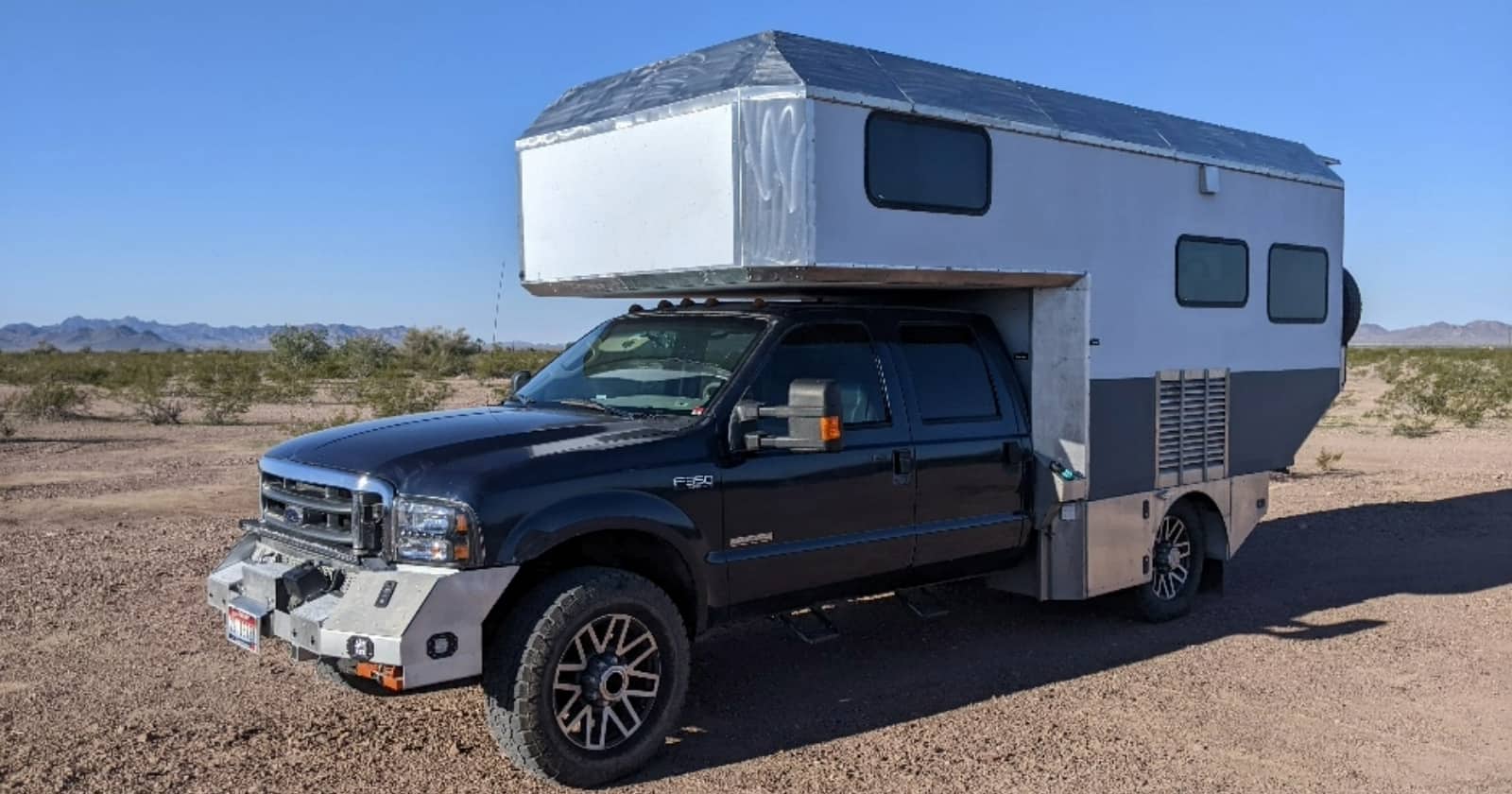Residential RV Fridge Swap: Upgrading from Norcold 2118 to Samsung RF18
The Norcold 2118 RV absorption refrigerator came standard in our RV. We used it for about three years, until we noticed our food was spoiling sooner than usual and our ice cream was feeling a bit soft. So, I started to periodically check the temperatures, and sure enough, the temps were creeping up a little too much during the warmest times of the day. Not good. I began to wonder if we were in for an RV fridge swap.
Troubleshooting our RV refrigerator
I started researching and troubleshooting until I finally found the source of our problem: an ammonia leak. This meant the fridge’s cooling unit was completely dead and couldn’t be repaired. So what now?
In my research, I discovered there were a few different options we had for solving our problem. We could do an RV fridge swap and get an exact replacement for over $5000 and hope it lasts longer than the original. Or, we could remove and replace the cooling unit with a new one from JC Refrigeration, for close to $2000…a considerable savings.
We could also convert the fridge to a 12V DC or 120V AC system with a conversion kit, also available from JC Refrigeration, for around $1600. Our last RV fridge swap option would be to get an entirely new, residential fridge for close to $1500. We ultimately decided to go that route, swapping out our Norcold unit for a residential refrigerator: the Samsung RF18.

RV fridge swap
In the video above, I take you through the troubleshooting steps I took to identify our specific problem. I also cover what repair and replacement options we had, and how much they cost. I dive into how we swapped out the fridges safely and easily, and finally, how we made back some of our money, and more!
Swapping to a residential fridge does take some planning, but with the help of the video above, an RV fridge swap is possible, and soon enough, it’ll all feel like water under the fridge. When your RV fridge isn’t cooling the way it should, it’s always best to chill out and come up with a well-thought-out plan before having a meltdown.
Remember, there’s absolutely no need to cry over spoiled milk, and that’s a cold hard fact. Don’t get cold feet…get a cold fridge!
About the Author
Chris and his wife travel and work full-time in their fifth wheel, creating informative content and interesting revenue streams for digital nomads and remote workers. Subscribe to their YouTube channel or visit their website.




Just responding to the comments about electricity for the residential fridge option. The budget for the approach may be misleading- I think the real cost would be greater than specified above.
We used to have a fifth wheel with a Norcold dual-fuel thing, and we hated it. Some stuff spoiled while other items froze solid in the “crisper” – etc. When we switched to our diesel pusher, I had zero interest in looking at any other “RV fridge.”
With the diesel, we certainly have a residential fridge and with the on-board quiet-diesel generator, I don’t worry about electricity, but if in a travel trailer or fifth wheel, it is going to be a concern because you can’t run the generator while driving down the road like we can with a Class-A.
1.) You will need more house batteries – assume about 2 more just for the fridge.
2.) You will want a 2000-3000 watt inverter that simply powers the outlets in the rig, including the fridge. You want a very efficient unit that isn’t bleeding off precious 12 volt reserves to heat.
3.) Easy answer for the comments from others – go solar. Trailers are great opportunities for solar panels, depending on where you travel, have enough of them to fully-charge your batteries within about 3-4 hours of the best daily sunlight. (10 am to 2 pm is the best for a trailer) – the panels are flat, not angled toward the sun, so you really need to get your charging handled during high noon.
4.) Batteries are physically a problem, too many may not fit. This is where lithium-ion earns the price tag – Li batteries are 100% usable – 100 amp-hours = 100 amp hours. AGM or Lead-Acid however will be considered depleted at the 50% mark – so 100 amp hours = 50 amp hours usable. In other words, you would only need half the Li batteries compared to AGM/Lead, but they do cost about 4x as much.
Adding those likely upgrades – the residential option is considerably more than the budget mentioned – but 12v will not save as much – more batteries and solar is likely, but not the inverter.
We have a residential frig and 400 watt solar panels with 2lithium batteries and the fridge runs all the time no problem it is connected directly to the battery’s
I would like to hear from people that have dry camped for more than 48 hours and ran their ABSORPTION fridge on propane. And checked the temperature of the freezer, The 12 volt units will keep the freezer at zero but do use a lot of battery power; if both compressors and all three fans are running they pull 11 amps. even with a 200 amp battery it will get weak in around 12 hours then you will need to run your gen and have a powerful charge,
Send me the results. Thank you, [email protected]
Do you dry camp or camp off grid and if so how much did it cost for a battery upgrade?
A few weeks ago, I installed a new cooling unit for our Norcold 1200 from JC Refrigeration. It has 2 compressors, one for the freezer and one for the main refrigerator compartment. It comes with either 12V or 110V AC power options. It is designed to be a DIY project. You do not need to remove a window to get it in! It cost $1625 with shipping and 10 gauge wiring. It requires two strong people to remove the old refrigerator with its cooling unit. We lowered it onto a Harbor Freight furniture dolly rated at 800#. The original refrigerator probably weighed about 250#. The dolly split in half! Getting it back in for me was easier than removing it. We used a hydraulic garage jack to raise it back up into position and just pushed it into its compartment. The old cooling unit is removed fairly easily and the new takes its place. The instructions are excellent. The most difficult part of the installation for me was getting it wired directly to the house batteries and I am not satisfied how I managed to do that. It is quiet and it cools down very, very quickly (if you haven’t cleaned the freezer before you start it up, you will have to clean it very quickly – that’s how fast it gets cold!). It is supposed to use less electricity than the original. If you don’t want to install if yourself, JC Refrigeration can do it for you at their factory in just a few hours. Doing it myself, it took about 8 hours. Finding a suitable residential refrigerator may be a real challenge and getting it installed will be very difficult plus it will require a constant 110V source, will heat up your living space and servicing it will be also difficult. If you have a the very common Norcold 1200 series, the JC Refrigeration upgrade should be included as a viable option.
I imagine being full time RVer’s entered in your decision to go residential. Our fridge has been going for 20 years without problems and would seriously think of going 12 volt compressor when I have to change it. I was hoping you would have info on that style v/s residential. I have several friends who’s wife saw the RV at the show and said that is what she wanted as they have a beautiful kitchen with the residential appliances. There has been nothing but complaints and fights about the fridge drawing down the batteries and the fact that the generator can’t run 24 /7 in most campgrounds to keep the residential fridge going. Think very carefully before you decide to go that route unless you stay in powered sites all the time.
I’m wondering the same thing. Are you full time stationary not actually driving. If you traveling how are you keeping appliance cold /running while on road.
As bad as NeverCold fridges seem to be (went to JC Refrigeration and h
Your fridge sounds great, but the elephant in the room wasn’t addressed which is power to the fridge and frankly the *only reason RV’s come with the ‘ammonia’ fridges to begin with.
By making the decision to swap out for a residential fridge, haven’t you more importantly (for many people anyway) made the decision to never be without electrical hook ups as well? You can no longer go off grid. Correct?
I know that’s ok for some people, but should be mentioned at least as it’s a deal breaker for so many. Also curious how you power it while you are going down the road. You must have a dc to ac inverter and you are asking your tow vehicle or motorhome engine to power that load by keeping your battery charged correct? Thanks for the article, just trying to fill in the blanks here.